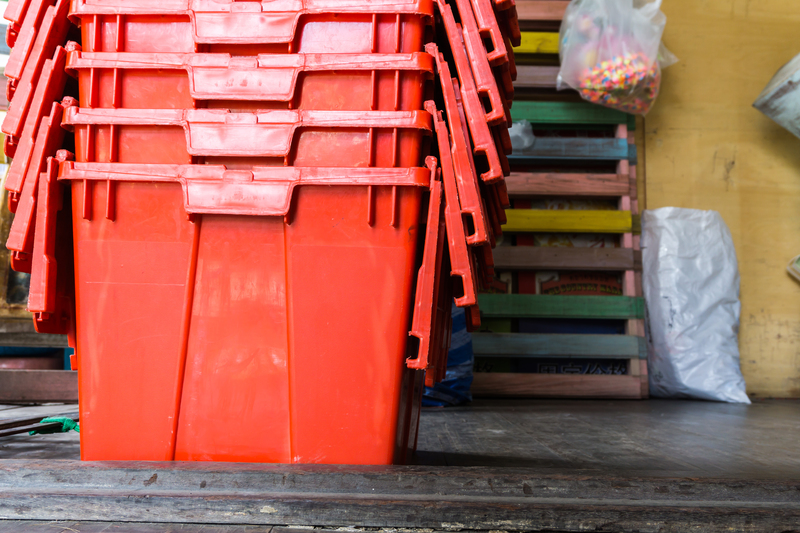The Ultimate Guide to Storing a Freezer When It's Not in Use
Posted on 17/05/2025
The Ultimate Guide to Storing a Freezer When It's Not in Use
Whether you own an upright freezer or a chest freezer, there comes a time when you may need to store your appliance when it's not in use. Perhaps you're moving, reorganizing your space, or just taking a break from bulk buying. Whatever your reason, properly storing a freezer can help maximize its lifespan, prevent unwanted odors, and ensure it's safe to use when you need it again.
This ultimate guide to storing a freezer when it's not in use covers every aspect of the process, from cleaning and defrosting, to protecting against pests, to the best placement strategies. Follow these steps for a well-maintained, problem-free freezer--ready to serve you whenever you need it.
Why Properly Storing Your Freezer Matters
Many people overlook the importance of storing a freezer properly when it's inactive. Failure to do so can result in a host of issues:
- Mold and mildew buildup inside and around the appliance.
- Unpleasant odors that can be tough to remove.
- Pest infestations--freezers can attract rodents or insects if not sealed and cleaned properly.
- Potential damage to wiring, seals, or internal components due to moisture, corrosion, or poor placement.
- Reduced energy efficiency or even total failure when you try to use it again.
Taking the time to understand the proper storage process is a smart investment in your appliance and your peace of mind.

Step-by-Step: How to Store a Freezer When It's Not in Use
1. Empty the Freezer Completely
The first step in temporary freezer storage is to remove all items. Discard any old or expired food. Remember, even a tiny spill can cause major problems if left unattended for months.
- Check all shelves, drawers, and compartments.
- Remove freezer trays and baskets for individual cleaning.
- Allow any ice or frost to melt naturally if you have an auto-defrost model.
2. Defrost Your Freezer
Properly defrosting your freezer before storage is crucial to prevent moisture buildup and mold. Here's how:
- Unplug the freezer from the power outlet.
- Prop the door open for airflow and let ice melt.
- Place towels around the base to absorb melting water.
- Once fully defrosted, wipe down the interior and remove any standing water.
Never use sharp tools to pick at ice, as this can damage the lining or tubing of your freezer.
3. Deep Clean the Interior and Exterior
A clean freezer is easier to store and less inviting to pests or bacteria. For a thorough clean:
- Use a mixture of baking soda and warm water (about 2 tablespoons per quart) to wipe down all surfaces.
- Scrub stubborn stains with a non-abrasive sponge.
- Wash trays, bins, and shelves separately and let dry completely.
- Wipe down the door gasket (seal) carefully, as dirt here can cause leaks and odors.
Don't forget the exterior--dust and debris can attract pests even if the inside is spotless.
4. Thoroughly Dry the Appliance
Moisture left behind is the chief cause of mold and odors in stored freezers. After cleaning, leave the appliance open for several hours in a well-ventilated area, using a dry towel to absorb excess water.
- Check all corners and crevices for hidden moisture.
- Let removable parts dry out fully before putting them back in.
You may place an open box of baking soda inside the unit to absorb lingering odors and moisture during storage.
5. Secure and Protect Moving Parts
If you're transporting or storing the freezer in a location with foot traffic, it's important to secure any loose parts inside:
- Tape trays and shelves in place, or remove and store them separately.
- Use bubble wrap or old towels to protect delicate parts.
If your appliance features a locking door, it's a good idea to lock it; otherwise, use a bungee cord to prevent accidental opening during moves.
6. Storing the Freezer Door--Open or Closed?
One of the most frequently asked questions when storing a freezer that's not being used is about the door--should it be left open or closed?
- Leave the door slightly ajar. This discourages mold, mildew, and stagnant odors by allowing air circulation.
- Prop the door open with a towel, a small block, or the freezer's own removable parts.
- You may use a child lock or rope to ensure the door doesn't swing wide open.
If you must keep the door closed, consider placing a silica gel pack or moisture absorber inside.
7. Choose the Right Storage Location
Where you store your freezer is just as important as how you prepare it. The best place for freezer storage when not in use is:
- Dry, cool, and well-ventilated rooms to prevent rust and mold.
- Off the ground--prop the appliance on pallets or blocks to avoid moisture from concrete floors.
- Avoid direct sunlight, which can damage plastics and cause warping.
- Keep away from pests; avoid garages or sheds unless they are secure and insect-proof.
Never store your freezer outdoors, as exposure to rain, snow, and temperature fluctuations can cause irreparable damage.
8. Cover and Protect the Freezer Exterior
Protect your freezer from dust, scratches, and accidental knocks by covering it. For best results:
- Use a breathable cover like a cotton sheet, not plastic, to avoid trapping moisture inside.
- Do not seal the unit in airtight wrap unless it's been specifically designed for long-term, transport-grade storage.
Label your freezer as "Out of Use" to prevent accidental plugging in or repurposing.
9. Regular Checks and Maintenance During Storage
If you plan to store your freezer for several months, occasional maintenance is a must:
- Open the door every 4-6 weeks to air out the interior.
- Check for signs of mold, moisture, or pests.
- Replace moisture absorbers or baking soda as needed.
- Ensure the appliance remains unplugged and the power cord is secure and undamaged.
Regularly monitoring your freezer during long periods of inactivity can catch minor issues before they become serious.
Special Tips for Storing Different Types of Freezers
Chest Freezer Storage
- Chest freezers often have deeper interiors and lift-up doors--ensure the lid stays slightly open.
- Stack removable baskets inside to prop the door safely.
- Securing the lid is especially important if the freezer is accessible to children or pets.
Upright Freezer Storage
- Upright models have shelves that can trap moisture--thorough drying is key.
- Check the seal along the vertical door carefully, as upright models are more prone to mold if left tightly shut.
- If moving, tape the door shut and wrap the appliance with padding for protection.
Preparing to Reactivate Your Stored Freezer
When it's time to bring your freezer back into use, a few simple steps can ensure it functions safely and efficiently.
- Inspect for signs of rust, pests, or moisture damage.
- Give the interior a quick clean, replacing baking soda if needed.
- Double-check the condition of power cords and the plug.
- Allow the freezer to stand upright for at least 4 hours (or as recommended by the manufacturer) before plugging in--especially if moved, to let refrigerant settle.
- Plug back in and monitor for proper cooling before stocking with food.

Frequently Asked Questions About Freezer Storage
Can I store my freezer in an unheated garage or shed?
While some freezers are garage-ready, most are sensitive to extreme temperatures. Cold weather can cause oil thickening, and excessive heat can damage electronic components. Always check your manufacturer's guidelines before choosing a garage or outdoor shed for storage.
How long can a freezer be left unused?
If cleaned and stored correctly, a freezer can sit unused for several months--or even years--without issue. However, longer storage requires periodic checks and moisture control to ensure a trouble-free reactivation.
Should I plug in my freezer occasionally while it's in storage?
Generally, it's best to leave the appliance unplugged to avoid electrical risks and unnecessary energy usage. Short power cycles won't help preserve the freezer and may encourage moisture condensation.
What's the most common mistake when storing a freezer?
Failing to fully dry the interior and leaving the door sealed shut. This creates a perfect environment for mold and mildew, which can ruin the appliance and make it unusable.
Conclusion: Protecting Your Investment
Proper freezer storage when not in use is about more than just finding an empty spot in your garage or basement. By taking a systematic, careful approach--including cleaning, drying, protecting, elevating, and regularly checking on your appliance--you'll keep it fresh, functional, and ready to go at a moment's notice.
Remember, a little effort now can save you from expensive repairs, wasted food, and headaches later. Follow this ultimate guide for storing a freezer when it's not in use, and enjoy the confidence of knowing your appliance is cared for--whether it's run daily or resting between uses.
Have More Questions?
If you need more tips or advice on storing household appliances and freezers, drop your question in the comments below or reach out to our appliance care experts. We're here to help you store smart and save!







